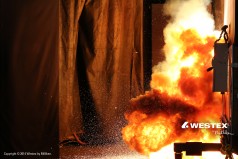
There’s a new acronym in the world of PPE, and it has been causing confusion, both among folks new to the subject as well as those long familiar with FR (Flame Resistant) clothing. The letters “AR” stand for Arc Rated, and made their debut in the recent revision of NFPA 70E; the short explanation of the difference is that ALL AR clothing is flame resistant (FR), but not all FR rated clothing has been Arc Rated.
In both cases, and indeed with all applications for FR clothing, the primary purpose of the clothing is to resist ignition (as tested by ASTM D-6413, also known as Vertical Flame Test). If flammable clothing is ignited by an arc flash, flash fire, molten metal, etc, the hazard to the wearer instantly becomes much greater, because a clothing fire will last much longer than the initial hazard, will typically burn the victim over a much larger body surface area and more deeply, and is more likely to result in airway and lung damage. By not continuing to burn after the initial hazard is over, FR clothing limits burn injury to, at most, only the body surface area directly impacted by the hazard (and it’s this reduction of TBSA –total body surface area- burn that’s most directly linked to survival). The second goal of FR clothing is to insulate the wearer from the thermal hazard, thus reducing or eliminating any 2nd or 3rd degree burn through the garments, even in areas directly impacted by the hazard. This is where arc flash rating comes into the picture.
All Arc Rated clothing is flame resistant; the official arc rating standard (ASTM 1959) requires fabrics be FR to even qualify for testing. Once an FR fabric is submitted for arc rating, 21 samples are subjected to arc flash, and sensors measure heat transfer through the fabric. Stoll curve modeling then predicts whether or not a second degree burn would result, and calculates the energy likely to cause a 2nd degree burn through that fabric 50% of the time. This number, expressed in calories, then becomes the arc rating for that fabric and any garment made from it. More simply put, arc rating measures insulation of FR fabrics to arc flash. The arc rating can be reported as ATPV (Arc Thermal Performance Value) or Ebt (Energy Breakopen threshold) – more on the difference between these in a future post- and is a single number, the higher the better.
The NFPA 70E committee wanted, understandably, to encourage people to specify and purchase fabrics which have been tested specifically for the arc flash hazard, rather than accepting any FR fabric off the open market, and thus created the “AR” designation. AR garments almost always have their arc rating displayed on an internal label, and occasionally on an external label as well. More often, the external label will bear a HRC rating number reflecting the HRC (Hazard Risk Category) the garment achieves (please note the “HRC” acronym is being changed in the next 70E revision, and we’ll cover that in a future blog post as well).
Since all AR garments are also FR, they will provide some measure of protection in a flash fire; indeed, the significant majority of well known AR fabrics are also offered for flash fire markets. However, arc rating is NOT a predictive factor in flash fire performance; the test standard for that is NFPA 2112. Fabrics pass this test if they record less than 50% 2nd and 3rd degree body burn in a 3 second flash fire (3 seconds because that was the defined upper limit of a flash fire and less than 50% because survival rates are much higher below 50%). The 2112 data is expressed as a percent body burn, rather than calories, and in this test the lower the number is, the better the fabric performs.
Again, all AR fabrics are FR, but not all FR fabrics have been arc rated. While virtually all of the best selling brands have been tested to both hazards, please make sure you specify and purchase fabrics tested for your hazards at independent labs.

